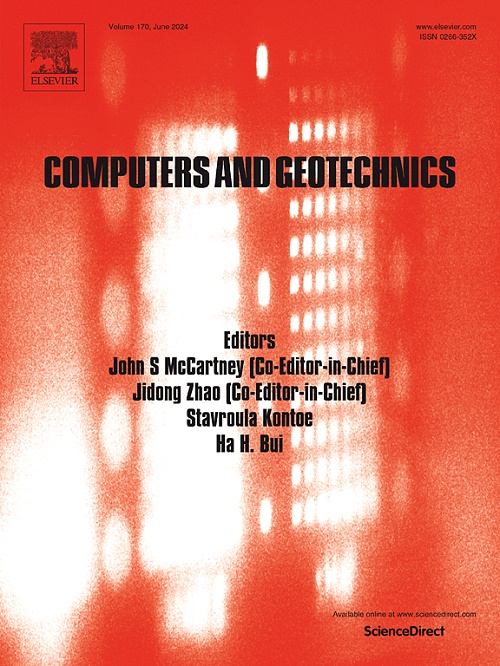Investigation on tunnel face failure under varying seepage conditions in saturated sand using coupled CFD-DEM and analytical modelling
IF 5.3
1区 工程技术
Q1 COMPUTER SCIENCE, INTERDISCIPLINARY APPLICATIONS
引用次数: 0
Abstract
Tunnels are increasingly being constructed in saturated sandy ground with high hydraulic head and permeability. However, limited attention has been given to face stability under various seepage conditions, which is critical for the safety of shield tunneling. To address this gap, a computational fluid dynamics-discrete element method (CFD-DEM) model was developed to simulate face failure under tunnel face seepage (TFS). The validated numerical model unveils that the specific discharge decreases exponentially with the increase of distance away from the tunnel face, but the increase of maximum specific discharge at tunnel face qface,max can expand this influence range from 0.5D to 2D. Due to the seepage force directed toward the tunnel face, tunnel face unloading induces a loosening zone with a shape of wedge and inverted frustum shape, where the inclination angle decreases as qface,max increases. Meanwhile, although the pressure afforded by the tunnel face can be alleviated by the soil arching effect, the TFS can weaken the soil arching effect and raise the limit support pressure (LSP). Based on the numerical results, the distribution of seepage force was derived and introduced into an equilibrium analysis. Thereby, an innovative analytical model for the estimation of LSP under TFS was proposed and verified. Additionally, the parametric study on the analytical model indicates that the pore pressure on the tunnel face center is inversely proportional to qface,max, with the decreasing ratio negatively correlated to the void ratio e and the spherical seepage reduction factor η0. Moreover, the LSP is positively correlated with qface,max, e, and C, and negatively correlated with η0 and internal friction angle.
基于CFD-DEM和解析模型的饱和砂土不同渗流条件下巷道工作面破坏研究
隧道越来越多地建在高水头和高渗透性的饱和砂土地上。然而,各种渗流条件下的工作面稳定性对盾构施工的安全至关重要,而工作面稳定性的研究却很少受到重视。为了解决这一问题,建立了计算流体力学-离散元法(CFD-DEM)模型来模拟隧道工作面渗流(TFS)下的工作面破坏。经验证的数值模型表明,比流量随离巷道端面距离的增加呈指数减小,但最大比流量的增加可以将影响范围从0.5D扩大到2D。由于渗流力指向巷道工作面,巷道工作面卸荷形成楔形、倒锥形松动区,其倾角随面减小,最大值随面增大。同时,虽然土拱效应可以缓解隧道工作面所承受的压力,但TFS可以减弱土拱效应,提高极限支护压力(LSP)。在此基础上推导了渗流力的分布规律,并将其引入平衡分析。由此,提出并验证了一种新颖的TFS下LSP估计分析模型。分析模型的参数化研究表明,隧道工作面中心孔压与qface,max成反比,其减小比与孔隙比e和球面渗流缩小系数η负相关。LSP与qface、max、e、C呈正相关,与η0、内摩擦角呈负相关。
本文章由计算机程序翻译,如有差异,请以英文原文为准。
求助全文
约1分钟内获得全文
求助全文
来源期刊

Computers and Geotechnics
地学-地球科学综合
CiteScore
9.10
自引率
15.10%
发文量
438
审稿时长
45 days
期刊介绍:
The use of computers is firmly established in geotechnical engineering and continues to grow rapidly in both engineering practice and academe. The development of advanced numerical techniques and constitutive modeling, in conjunction with rapid developments in computer hardware, enables problems to be tackled that were unthinkable even a few years ago. Computers and Geotechnics provides an up-to-date reference for engineers and researchers engaged in computer aided analysis and research in geotechnical engineering. The journal is intended for an expeditious dissemination of advanced computer applications across a broad range of geotechnical topics. Contributions on advances in numerical algorithms, computer implementation of new constitutive models and probabilistic methods are especially encouraged.
 求助内容:
求助内容: 应助结果提醒方式:
应助结果提醒方式:


